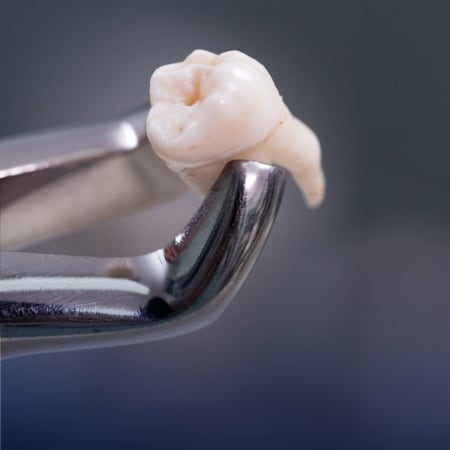Wisdom teeth are the final adult teeth to emerge. Including the front teeth, canines, and four molars on each side, top and bottom, 28 teeth can fit comfortably in your mouth.
Most adults’ mouths aren’t large enough to handle extra molars. Therefore, wisdom teeth extraction may be necessary for some people. Because there isn’t enough room for the wisdom teeth to grow, they might grow crooked and cause misalignment issues among the other teeth.
After the wisdom teeth extraction, there will be holes, also known as sockets, left behind where the teeth used to be.
To avoid dry sockets, following the aftercare instructions provided by your oral surgeon is important. Aftercare can include medications, careful eating and drinking, and cleaning and caring for the extraction site.
A successful wisdom teeth surgery will include healthy blood clots in the sockets.
What Is Dry Socket?
Following wisdom teeth extraction, a blood clot forms in the tooth socket—the space where the tooth was before—and closes off the area so it can recover. A dry socket happens when the blood clot dissolves or is displaced, exposing the bone and nerves.
The first 5 days after surgery are the most essential, as this is when the danger of a dry socket is greatest. A dry socket can be agonizing, and it’s important to contact your oral surgeon right away if you are experiencing pain from a dry socket.
Wisdom Teeth Removal
Wisdom tooth extraction is typically performed under intravenous (IV) sedation or general anesthesia to help you be more comfortable in a sleep-like state. These choices and the risks associated with surgery, such as sensory nerve injury and sinus issues, will be reviewed with you before the treatment.
After removing your wisdom teeth, the area will be sutured, and you’ll have to bite down on gauze to stop bleeding. Until you are well enough to be transported home, you may recuperate under the watchful eye of oral surgery nurses.
You will receive a postoperative toolkit on your way out that includes recovery guidelines, a prescription for painkillers, and, if necessary, antibiotics.
Your oral surgeon can advise you on what to eat and drink and how to clean and handle the socket area. The socket should mend in 7 to 10 days with proper care and relaxation.
Risk Factors for Dry Socket
When the blood clot breaks down or does not develop properly, it results in a dry socket. The air has access to bone and nerves, which can cause discomfort and hold up the healing process.
You may be more at risk of developing a dry socket if any of the following apply to you:
- Poor dental health
- Challenging tooth extraction
- Use birth control tablets
- Use tobacco products
- Not caring for your mouth properly or following the aftercare instructions
- Have experienced a dry socket before
- Spit and rinse a lot, causing the blood clot to come loose
Remedies for Dry Socket
Having a dry socket can be uncomfortable. However, it’s preventable. In addition to your dental professional’s aftercare, you can try the following at-home remedies for dry socket prevention. Before attempting home remedies, make sure to speak with your oral surgeon.
Rinse with Salt Water
Using salt water to rinse your mouth 48 hours following extraction can help you avoid the onset of a dry socket. According to a study, patients who didn’t use a saltwater rinse following an extraction had a higher risk of getting a dry socket than those who had. Gently rinse salt water twice daily to reduce your chance of developing a dry socket.
Keep Hydrated
After tooth extraction, consume liquids, such as clear broth or water, to aid your recovery. You can prevent negative effects of painkillers, such as nausea, by staying hydrated. Don’t use a straw when drinking, as the pressure from the straw can cause the blood clot to become dislodged.
Watch What You Put in Your Mouth
While recovering from a tooth extraction, eating using the area where your tooth was should be avoided until your mouth heals. Soft meals, such as pudding or soup, may be easier to consume and can aid in healing. Additionally, being mindful of what you put in your mouth is critical. Smoking is discouraged while the body is recuperating.
Cold Compress
Apply an ice pack or cold compress on your cheek for 10 to 20 minutes, if necessary. For the following 3 days, try this every couple of hours or until the swelling subsides. Never put the ice or compress directly on your skin. Instead, wrap it in a light towel.
How Long Does Wisdom Teeth Extraction Take?
Plan to be in the dental office for approximately 1.5 hours from start to finish for the tooth removal surgery. This time frame comprises 30 to 45 minutes for the extraction and 15 to 20 minutes for recovery.
This time may vary, depending on the nature of the surgery and how quickly you awaken after sedation.
Consulting an Oral Surgeon
The first step is to get a referral from your regular dentist to see an oral surgeon at CVOS Oral Surgery for a consultation. The surgeon can then perform a complete oral examination and study X-rays of your mouth to confirm the position of your wisdom teeth and recommend a strategy for treatment.
If you need to have wisdom teeth removed, the earlier you deal with them, the easier it will be to perform the surgery and the quicker the recuperation period.
Even though some home cures may help prevent dry sockets, it’s still crucial to follow an oral professional’s aftercare instructions and visit your surgeon if you have developed a dry socket after a tooth extraction.









